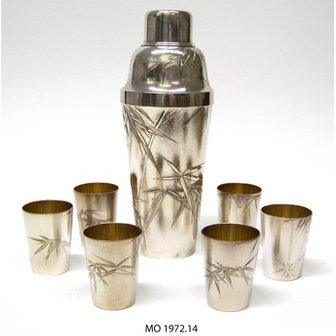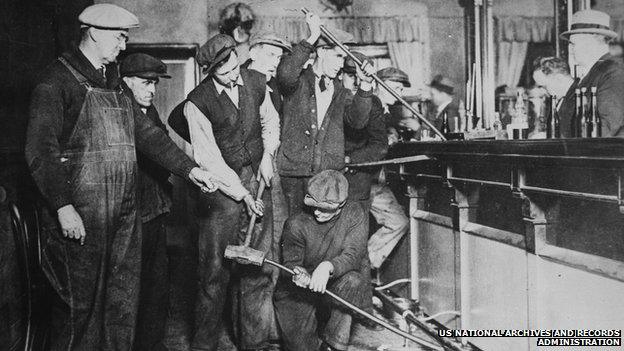The time when Americans drank all day long
- Published
A new exhibit looks at the highs and lows of drinking in America.
A new exhibit looks at the history of drinking in America.
The Puritans get a bad rap in America - especially when it comes to alcohol. They are generally blamed for putting the dampeners on any form of fun, and many people assume that it was the nation's puritanical roots coming to the surface when Prohibition was introduced in 1917.
But while they weren't exactly party animals, a new exhibition at the US National Archives reveals that the Puritans actually approved of drink.
"One of the things we understand now is that the initial ship that came over from England to Massachusetts Bay actually carried more beer than water," says Bruce Bustard, senior curator of Spirited Republic: Alcohol in American History.

Betty Ford spoke openly about her struggles with alcoholism
In fact Increase Mather, a prominent Puritan minister of the period, delivered a sermon in which he described alcohol as being "a good creature of God" - although the drunkard was "of the devil."
Early Americans even took a healthful dram for breakfast, whiskey was a typical lunchtime tipple, ale accompanied supper and the day ended with a nightcap. Continuous imbibing clearly built up a tolerance as most Americans in 1790 consumed an average 5.8 gallons of pure alcohol a year.
"We think of that as an astounding amount - you would think people would be staggering around drunk, but most people were able to handle their alcohol because it was integrated into daily life." says Bustard.

FDR's cocktail shaker
This was also a period when most people were working in the fields which presumably didn't require much focus. And living in a tight knit community meant people could keep an eye on each other and intervene if somebody was thought to be overdoing it. Even so, modern Americans look quite abstemious by comparison, consuming only two gallons of pure alcohol per year.
In 1830, consumption peaked at 7.1 gallons a year and drinking became a moral issue.
"This was a time of great reform fervour," says Bustard. "Think of the women's rights movement and anti-slavery movement. Another very popular and powerful movement was the temperance and ultimately Prohibition movement."
Alcoholism - also known as dipsomania - was starting to have a serious impact on communities. Women and children might be in physical danger if the man of the house began drinking. If he became ill or lost his job through drink, there was no social safety net to support or protect his family.
In 1862 the US Navy abolished the traditional half-pint daily rum ration for sailors, and by the late 19th Century support for Prohibition, banning the manufacture and sale of alcohol was overwhelming. On 16 January 1919, the 18th Amendment, which set Prohibition into law, became part of the Constitution.
Many famous figures emerged from the era - the Chicago gangster boss Al Capone being the most notorious. But the National Archives exhibition reveals details of some lesser-known heroes who fought on the side of the law.
Isidor "Izzy" Einstein was an immigrant from Austria-Hungary who had no experience in law enforcement. Nevertheless, he made his name arresting almost 5,000 people accused of bootlegging, and enjoyed a 95% conviction rate.


Avenger pilot Roland Gift relaxes in the USS Monterey after a night landing
Drinking Data
The Founding Fathers liked a drink - Samuel Adams was a partner in his father's malt house and Thomas Jefferson was famed for importing European wines.
By the late 19th Century, dipsomania, or alcoholism, was being treated as a disease.
The first arrest for driving under the influence of alcohol was in 1897.
In 1955 the first breathalyser was patented.
Americans drink an average of 2.3 gallons of pure alcohol a year compared to 7.1 gallons in 1830.

He and his partner Moe Smith often worked in disguise but also tipped off reporters in order to get favourable news coverage. That publicity and their lack of professional experience eventually led to both being dismissed.
But prohibition did not ban alcohol consumption and many Americans found legal and not so legal ways to carry on drinking. The speakeasy was born, organised crime moved in and alcohol became big business. The cost of enforcing prohibition itself became prohibitive.

By the 1930s it was widely believed that making alcohol legal again would provide much needed jobs and taxes during the Great Depression. And on 16 February 1933, the 21st Amendment ended Prohibition.
"America now has a mishmash of local, state and federal controls of alcohol and part of that is a legacy of Prohibition," says Bustard. "The Prohibition movement was still quite strong after Prohibition ended and it led to a lot of local prohibition on alcohol and state level probation."
The American presidency has done a lot to rehabilitate alcohol and make it respectable again. Betty, the wife of Gerald Ford may have given her name to an alcoholic treatment centre, but Presidents Richard Nixon, Jimmy Carter, Bill Clinton, Ronald Reagan and Barack Obama can all be seen on film drinking socially and making official toasts with international dignitaries.

Prohibition propaganda
And another exhibition highlight is the silver cocktail set once owned by President Franklin D Roosevelt.
"He had a tradition of having a small cocktail party with his most immediate staff and there were only two rules; FDR would make the drinks - and apparently he made very strong cocktails - and the other rule was that there would be no business discussed. It was a time for him and his staff to relax at the end of the day, so for him this cocktail set had a very positive association," says Bustard.
"But I also like to think about what his wife Eleanor might have thought about it because both her father and her brother were alcoholics. While she wasn't a teetotaller, she didn't use much alcohol at all. So I think she would have had a very different view of this very same object."